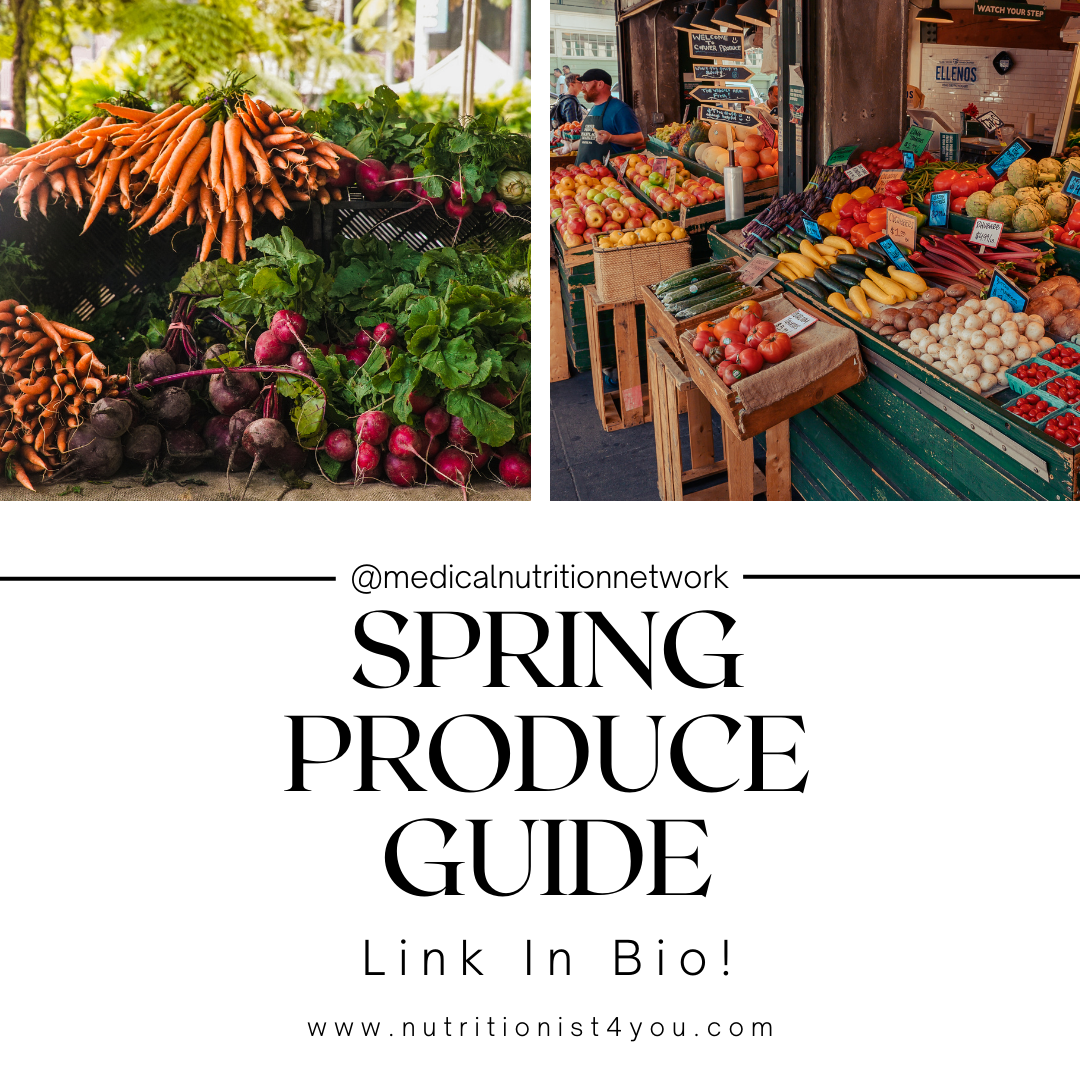Spring Produce Guide
Now that spring has sprung, it’s time to stock your refrigerator with warm-weather fruits and vegetables. Eating seasonally is a wonderful way to support local farmers and reduce your carbon footprint. The crop is picked right at the peak of the season, when it is fully developed and has spent an optimal amount of time under the sun. These prime growing conditions result in nutritionally-dense food with high levels of antioxidants.
At Medical Nutrition Network, we highly recommend shopping for seasonal produce at a nearby farmers’ market. It’s a great way to connect with your community and foster relationships with bakers, artisans, and other food workers who help bring nature to your dining room table. Plus, foods bought locally and in season are less likely to have been treated with heavy amounts of pesticides, herbicides, and preservatives. It’s budget-friendly, too; local farmers don’t have to worry about extensive storage and transportation costs, and you’ll see the difference reflected in your bill.
If you’re overwhelmed, let us help you out with our Spring Produce Guide. Read below for more information about supplementing your diet with fresh, perfectly ripe fruits and veggies. As always, if you’re looking for a meal plan with a personalized approach, contact a Registered Dietitian Nutritionist. An RDN can tailor your diet to meet your needs, no matter the season!
Apricots. Closely related to peaches and plums, this soft, tangy fruit offers a myriad of benefits. It’s full of vitamin A, C, niacin, and dietary fiber, meaning this powerful treat will help regulate your digestive system and promote heart health. You can tell an apricot is ripe when it turns a deep, ruddy orange and emits an unmistakable floral scent. Let an apricot work its magic in a granola parfait, or cut it in slices and mix into an arugula salad for a surprising (and delicious) pop of sweetness.
Grapefruit. Like its other citrus counterparts, grapefruit is an amazing source of Vitamin C. One medium grapefruit will give you 100% of the daily requirement of this immunity-boosting antioxidant! Certain studies have shown that regularly eating grapefruit may potentially prevent insulin resistance. According to PubMed, eating grapefruit is “generally associated with better blood sugar control and a reduced risk of type 2 diabetes.” Squeeze it into a smoothie, or add it to a citrus risotto.
Carrots. This root vegetable is chock-full of beta-carotene, which the body turns into Vitamin A. This vitamin keeps your eyes healthy and your lungs working the way they should. While most people are accustomed to seeing the orange iteration of this power veggie, carrots come in many colors and can beautify a salad in a pinch! Dip carrots in hummus for a healthy, crunchy snack, or soften them into a chicken-noodle soup for a textually diverse comfort food or roast Les Petites multicolored carrots for a beautiful side dish.
Kale, collard greens, and spinach. Dark, leafy greens are abundant with “carotenoids-antioxidants that protect cells and play roles in blocking the early stages of cancer,” according to the United States Department of Agriculture. These nutrient dense foods are incredibly versatile and offer a diverse range of nutrients. They fight belly bloat, support brain function, and regulate blood glucose levels. Their value cannot be understated. Include them in a fruit smoothie, in a side salad, or with a stir fry. Lucky for you, we have a great recipe for a springtime kale & quinoa salad on our website! Check out the Recipes tab, then Salads for more.
Asparagus. When it comes to this fibrous, filling vegetable, there is a lot more than meets the eye. Asparagus contains anti-inflammatory properties, as well as being rich in folate and potassium. It acts as a prebiotic, restoring gut health by feeding beneficial bacteria along the digestive system. You’ll know if asparagus is ready to eat when it takes a lovely green hue, fading to white at the bottom of the stalk. Make sure you’re eating the freshest asparagus possible by avoiding dull-colored produce. Toss with garlic, lemon, and parmesan cheese, then roast in the oven for a tasty side dish.
Artichoke. In Greek mythology, Zeus turned a goddess into an artichoke when he discovered she had been making secret trips away from their love nest on Mount Olympus. Truth be told, the artichoke is so powerful, it’s no surprise it has mythic origins. Plucked off of stalks that can grow up to three feet tall, artichokes offer surprisingly high levels of protein. They also contain polyphenols, which repair damaged cells and boost immunity. This whole food is tastiest when steamed or grilled; if you’re looking for a simple recipe, head over to the Vegetables tab and check out our instructions!
Share your seasonal recipes and grocery hauls by tagging us on Instagram @nutritionist4you. Happy Spring!
